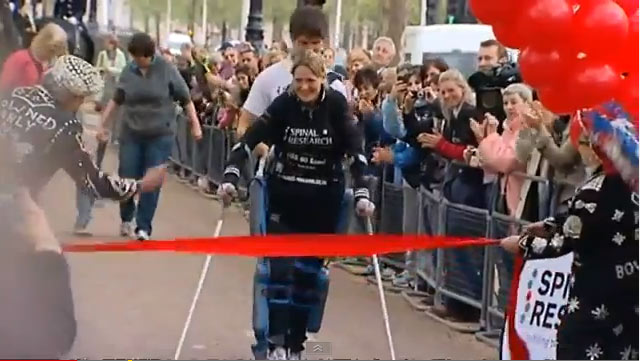Iron Woman: Paralyzed Mom Finishes Marathon With Bionic Legs


It took 16 days, but Claire Lomas of England, paralyzed from the waist down after a horse-riding accident in 2006, completed all 26.2 miles of the London Marathon last week with the help of robotic legs.
She had with her at the finish line her 13-month-old daughter, Maisie — also being assisted with her walking, albeit lovingly, by an adult, being the shaky toddler that she is.
But Lomas didn't seem to mind that she came in last place; she pushed just as hard as the other racers, she said.
"It was very challenging on my arms and hard mentally, because I can't feel my legs, and I had to concentrate on every step," Lomas told the BBC.
Lomas isn't the first paraplegic to finish a marathon. Dozens, in fact, completed the 2012 London Marathon in wheelchairs, zipping across the finish line in a few hours, not days. Many, however, consider Lomas' accomplishments all the more pioneering. She is the first person to "run" a marathon with robotic legs. She was outfitted with a bionic walking device called ReWalk, a 40-pound (18-kilogram) motorized exoskeleton created by an Israeli company, Argo Medical Technologies. [Bionic Humans: Top 10 Technologies]
At about $70,000 apiece, ReWalk isn't cheap. And you could argue that it isn't very practical, given the fact that most paraplegics can get about reasonably well in a wheelchair. Yet ReWalk and similar first-generation robotic devices represent a promising future for humans with compromised mobility.
E. Paul Zehr, a neuroscience expert at the University of Victoria in British Columbia, Canada, describes this type of application for robotic-mobility devices in his book, "Inventing Iron Man: The Possibility of a Human Machine" (Johns Hopkins University Press, 2011).
Get the world’s most fascinating discoveries delivered straight to your inbox.
"Tony Stark would be proud," Zehr said of Lomas, comparing her to the man behind the robotic Iron Man suit. "This is an example of applying the Avengers' Iron-Man-style exoskeleton to help with mobility ... applying superhero science to help with real-world problems."
The ReWalk device is challenging to use. Lomas could only walk about 1.5 miles daily. That is, this is no robot doing all the work, moving her legs for her. Rather, Lomas must control the sophisticated machine through upper-body movement while balancing herself with crutches.
Leaning forward triggers the ReWalk machine to lift the legs. Without a constant, rhythmic motion forward, the wearer would cease to walk and fall backwards into a sitting mode; without strength in the shoulders and hands on the crutches, the wearer would fall forward.
In this regard, Zehr said, the ReWalk suit is akin to the Iron Man suit in that the user must develop the coordination to make the device become one with the body. Iron Man, after all, wasn't a knight in armor; his suit was an extension of himself. Similarly, Lomas is becoming an "iron woman" by virtue of the constant mental awareness needed to make the robot move her legs the way she needs them moved — over uneven terrain or up stairs, for example.
Next-generation devices will push new boundaries in mind-body-device control, Zehr said. With months, if not years, of dedicated training, the body can create new neural connections in the brain to treat the artificial limb or mobility device as a natural extension of the body.
We are still years away from the technology to allow a paraplegic to learn to walk effortlessly, said Zehr. Aside from advances in technology, we need a better understanding of how the brain can interact with machines, he said.
But the first step is, in fact, a step ... lots of them, one by one, in a device such as ReWalk, over the course of 16 days and 26.2 miles (42.2 kilometers). Lomas is, quite literally, a walking experiment. She was the first to complete a marathon with bionic legs, but she won't be the last.
Christopher Wanjek is the author of the books "Bad Medicine" and "Food At Work." His column, Bad Medicine, appears regularly on LiveScience.

Christopher Wanjek is a Live Science contributor and a health and science writer. He is the author of three science books: Spacefarers (2020), Food at Work (2005) and Bad Medicine (2003). His "Food at Work" book and project, concerning workers' health, safety and productivity, was commissioned by the U.N.'s International Labor Organization. For Live Science, Christopher covers public health, nutrition and biology, and he has written extensively for The Washington Post and Sky & Telescope among others, as well as for the NASA Goddard Space Flight Center, where he was a senior writer. Christopher holds a Master of Health degree from Harvard School of Public Health and a degree in journalism from Temple University.


